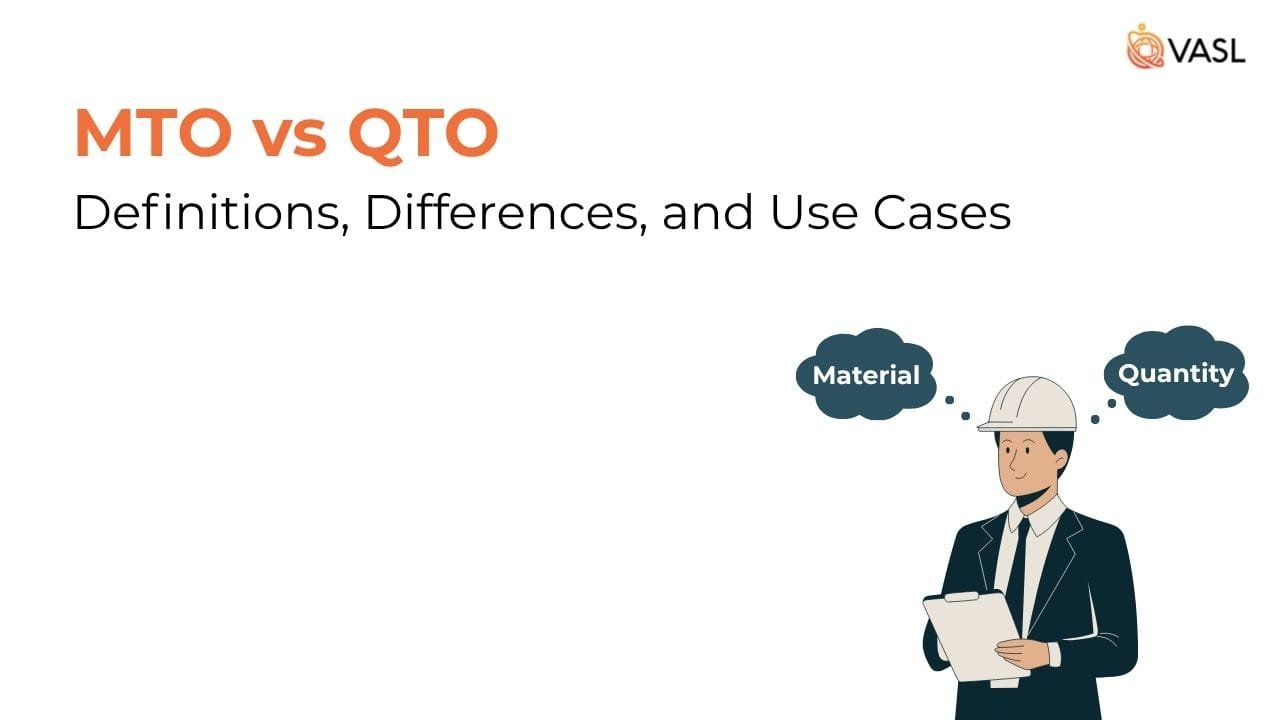MTO vs QTO: Definitions, Differences, and Use Cases
Introduction
For U.S. contractors, trade professionals, and general contractors, understanding the difference between Material Takeoff (MTO) and Quantity Takeoff (QTO) is essential to estimating accurately. Misunderstanding the difference between the two can result in missed materials, inaccurate bids, and lower profit margins. In this post, we’ll break down MTO vs QTO—what they are, when to use each, how they differ, and how using both improves your project success.
What Is QTO (Quantity Takeoff)?
Quantity Takeoff (QTO) is the process of identifying and calculating the number of measurable construction components required for a project. This includes surface areas, lengths, volumes, and counts of items such as drywall, piping, and fixtures.
QTO Examples
- 3,000 square feet of asphalt shingles
- 200 linear feet of 6-ft chain link fence
- 25 cubic yards of poured concrete
- 150 light fixtures
QTO forms the foundation for project estimation, helping to quantify scope and identify labor, equipment, and material needs.
What Is MTO (Material Takeoff)?
Material Takeoff (MTO) is a more detailed list derived from QTO that specifies the types and specifications of materials needed to complete a job. MTO includes brand names, performance specs, and code compliance data necessary for procurement.
MTO Examples
- Owens Corning Duration shingles, 3,000 sqft, color: Onyx Black
- 6’ high Galvanized 9-Gauge Chain link with top rail
- Lithonia 6-inch IC-rated LED Recessed Downlights
MTO ensures your project complies with specs, avoids procurement errors, and aligns with your RFQ and vendor submittal requirements.
H2: MTO vs QTO: Key Differences
Feature |
QTO (Quantity Takeoff) |
MTO (Material Takeoff) |
|
Purpose |
Measures quantities |
Details materials needed |
|
Output Format |
Area, length, volume, units |
Brand names, specs, descriptions |
|
Used For |
Estimating, budgeting, scope |
Procurement, compliance, RFQs |
|
Level of Detail |
General |
Specific and code-compliant |
| Primary User | Estimators, PMs |
Procurement teams, subs |
When to Use QTO
QTO is ideal during early planning and bid stages. It’s useful when:
- You need rough estimates for labor and cost.
- You’re bidding multiple jobs and need fast scoping.
- You want to compare bids or validate subcontractor pricing.
- Your project scope is evolving and final specs aren’t yet set.
By getting QTO right, you avoid underbidding or overpricing jobs.
When to Use MTO
Use MTO when you’re ready to:
- Order exact materials with specs and vendor details
- Send RFQs for pricing comparisons
- Create detailed submittals for client or architect approval
- Ensure compliance with code or green building certifications
MTO prevents costly mistakes, like ordering incompatible materials or not meeting bid requirements.
Why You Need Both for Accuracy
Relying solely on QTO leaves room for error. Without MTO, you risk:
- Ordering incorrect or insufficient materials
- Missing warranty and spec requirements
- Delays from unavailable brands or substitute materials
QTO tells you how much. MTO tells you exactly what.
Combined, they help you:
- Reduce material waste
- Avoid rework
- Win bids by showcasing professionalism
Tools Used for MTO vs QTO
At VASL, our estimators use:
- PlanSwift – Fast visual takeoffs from architectural drawings
- Bluebeam – High-accuracy scaling and plan markup
- AutoCAD – Extraction of dimensions and detailed elements
- RSMeans – Nationally benchmarked U.S. material and labor cost data
- Vendor Catalogs – Brand-specific pricing and product information
We produce estimates in your preferred format (Excel, CSV, PDF) and support your internal systems.
MTO vs QTO Across Trades
Roofing
- QTO: Square footage of surface, slope area
- MTO: Shingle brand, flashing, drip edge, ice/water barrier
Fencing
- QTO: Fence length and number of posts
- MTO: Gauge, finish, post caps, tension wire specs
Electrical
- QTO: Count of fixtures and outlets
- MTO: Model number, voltage, UL rating, junction boxes
HVAC
- QTO: Duct length, register count
- MTO: Duct gauge, insulation type, brand of diffusers
Drywall
- QTO: Wall and ceiling surface areas
- MTO: Board thickness, fire-resistance rating, screw pattern
In-House Estimating vs Outsourcing
Hiring full-time estimators can cost $70K+ annually, excluding benefits and software.
VASL helps you scale by offering:
- On-demand estimating teams
- Trade-specific experts
- U.S.-based code knowledge
- Lower fixed costs — pay per job
Our clients typically save 40–60% by outsourcing takeoffs.
How VASL Helps You With MTO vs QTO
We support GCs, subs, and trade professionals across the U.S. with:
- Dual QTO/MTO estimates
- Clean deliverables with spec sheets
- Fast 24–48 hour turnaround
- Customized output using your price guides
Whether you need estimates for roofing, fencing, or a full renovation scope — we deliver consistent, accurate, and affordable support.
Final Thoughts
Understanding MTO vs QTO is essential if you want to bid confidently, order the right materials, and stay on budget.
MTO ensures your purchases match the plan. QTO gives you the roadmap.
Want accuracy without adding overhead? VASL offers trade-specific estimating services that help you win more jobs.
Email: saman@vasl.team
Schedule a Call: Book here
Explore Services: VASL Estimation Services
